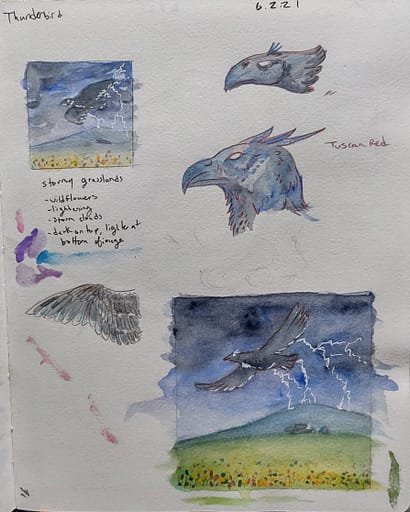I learned so much illustrating and self-publishing my first children’s book. From a person who didn’t receive formal training in book publishing or marketing, I had my work cut out for me. For a long time, I’ve been wanting to jump into the book illustration industry. I finally took the plunge and created my own personal project to showcase my skills and learn some new ones along the way. Below are a few realizations I had while brainstorming, problem-solving, and working on “ABCs of Beasties“. I hope by sharing these pieces of advice that it helps any other artists who are planning on getting into self-publishing as well.
Digital is easier to edit than traditional.
Digital artwork is definitely easier to edit and refine than traditionally created artwork. By creating my first book with ink pen and watercolor, I had to scan my artwork into Affinity Photo and make edits as needed. By using strictly digital art I could cut out time spent scanning and color fixing, among other things. It would be easier to plan out bleeds and trim boundaries as well by creating digital templates in which to illustrate within.
What do I plan to do with this newfound knowledge? As I work on my next books, I plan on incorporating more uses of digital tools into my work. I love working traditionally in watercolors and ink, but I think I could get more interesting images by combining the two mediums. Of course, I’ll definitely practice these new techniques before incorporating them into my finished projects!
Thumbnails are necessary.
Creating thumbnails is super helpful. I did this with each page of “ABCs of Beasties” to plan out my compositions and color choices (more on color below). After reading articles and advice from other illustrators many of them said to thumbnail at least three different versions of each image. It will be especially helpful when keeping important elements of the image away from the edges and better plan for areas of text.

What do I plan to do with this newfound knowledge? I always sketch out ideas before committing to them but I think I will take more time in thumbnailing from now on. Plus, I enjoy the sketching and ideating process!
Consistent color schemes help cohesiveness.
Sticking to similar color palettes throughout an entire book will help cut down on time spent color planning (whole book vs individual pages) and enhance overall cohesiveness. Since each page of “ABCS of Beasties” was its own individual story with each beastie representing a letter of the alphabet, I treated each page as its own entity. I picked a section of the color wheel and made my selections from there. This definitely increased my time spent on considering color choices, even though I enjoyed the coloring process.
What do I plan to do with this newfound knowledge? Going further I will choose a general color scheme and stick to colors within that section of the color wheel for the entire book. This will be especially important as I delve into narratives that tell a story across multiple pages.
Simplify Characters
I’ve always been a fan of characters drawn with lots of details, so this was a bit of a learning curve for me. Characters in children’s books are generally drawn in a simpler style to facilitate ease of drawing the same child, animal, house, etc. across an entire book. When a character is drawn simpler it abstracts them a bit, it leaves room for the reader or pre-reader (babies and toddlers) to input themselves into the story. I simplified my usual drawing style for “ABCs of Beasties” and that was big help in creating 26 beasties for the alphabet…But man, it still took a long time.
What do I plan to do with this newfound knowledge? Keeping the above points in mind, will help me in not agonizing too much over my drawing style being more ‘childish’. Simpler doesn’t always mean that not enough effort was put into a drawing, compared to a detailed pen and watercolor drawing of my past work.
In conclusion
When I finally hit ‘publish’ and saw my book go live on Amazon KDP, I could finally step back and assess my self-publishing journey as a whole. From initial composition sketches, to posting and sharing news of my children’s book, it was a lot of work! “ABCs of Beasties” definitely took a long time to complete, but I learned so much illustrating and self-publishing my first children’s book. Now I am pushing forward on my second children’s book with all the knowledge I gained from my first project.
Onwards to the next adventure!
What about you? Are there any other questions about self-publishing you’d like me to address? I didn’t really go over setting up my book in Canva or marketing so if that’s something you’d be interested in learning more about, let me know in the comments below.
In Case You Missed Them:
- “ABCs of Beasties” is Now Live! – my 1st book baby announcement
- “Death is Nothing At All” – life updates and a beautiful poem about grief
All of these are great points that I hadn’t even considered. It’s amazing how much work goes on behind the scenes, when we open up a book it’s the millionth copy that is polished to perfection. Thank you for sharing this bts!